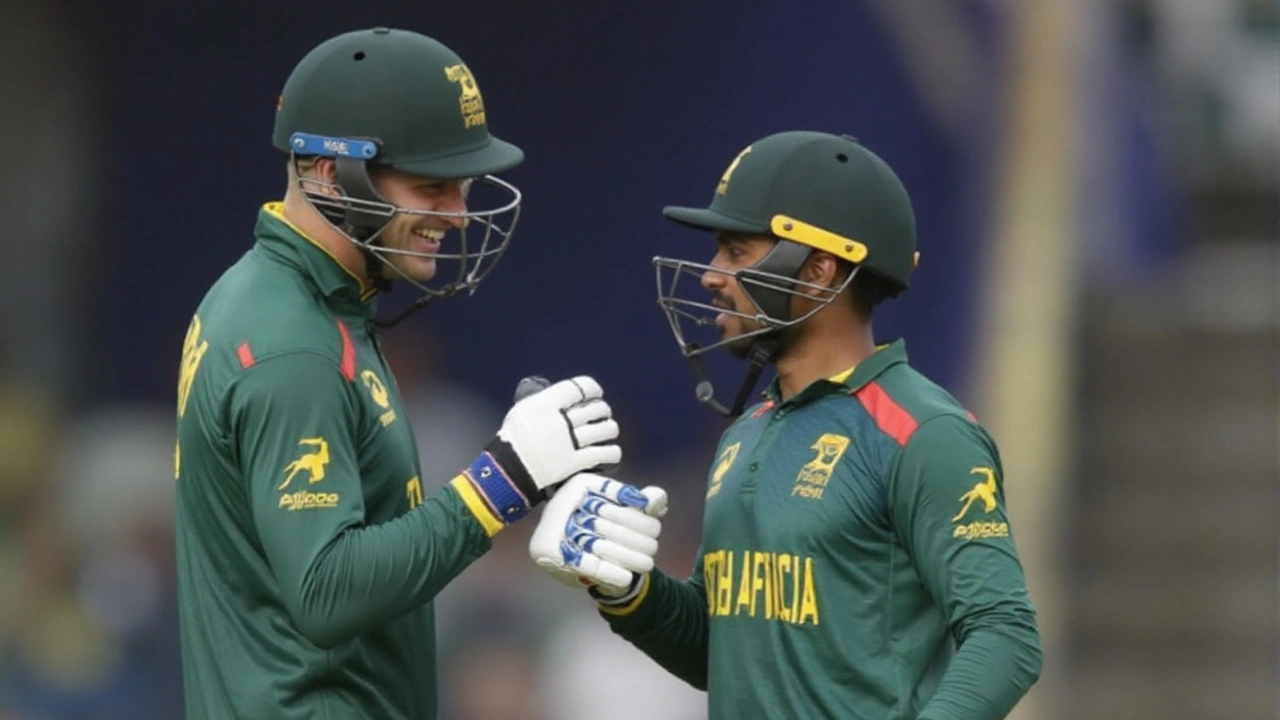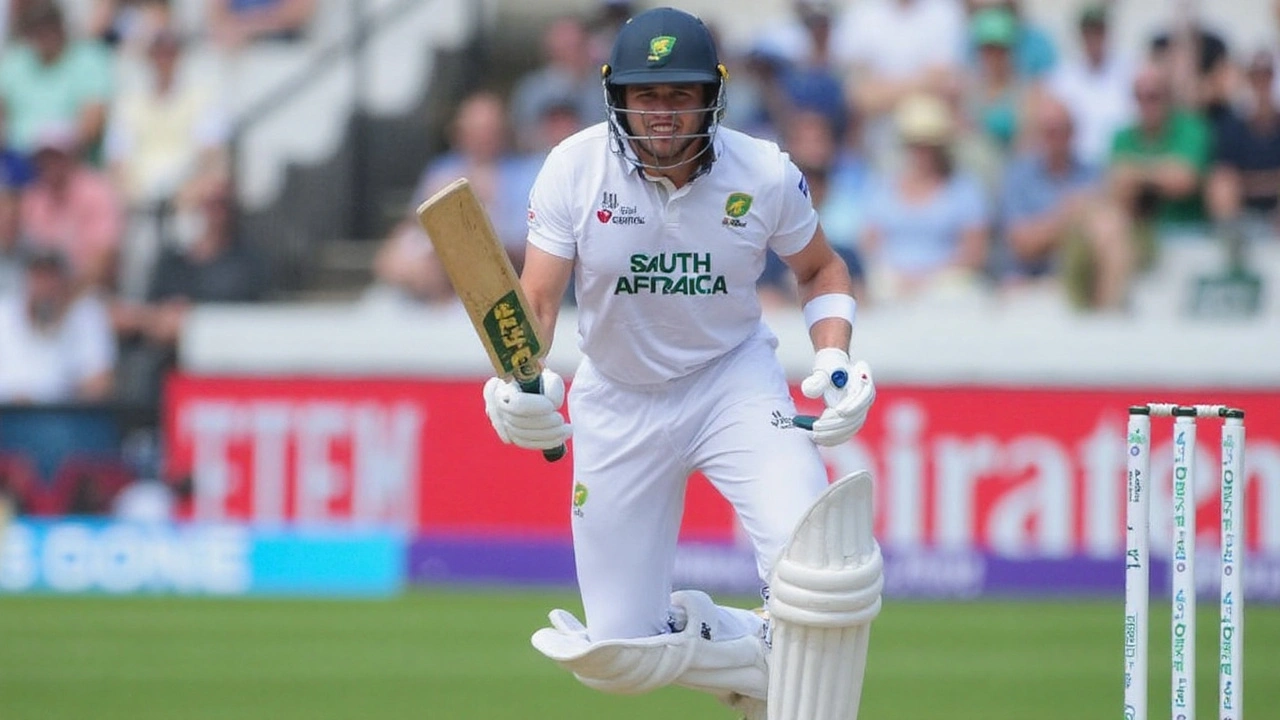Squad announcements and captaincy shuffle
Cricket South Africa dropped a heavyweight announcement on Tuesday, revealing three different captains for the upcoming multi‑format series in Pakistan. The move comes after regular Test skipper Temba Bavuma suffered a calf strain that rules him out of the October‑November 2025 fixtures.
Veteran all‑rounder South Africa cricket tour Pakistan will now be led in the Test arena by Aiden Markram, who has already been wearing the T20I captain’s hat. Markram’s resume includes 16 ODIs as stand‑in captain, eight wins from those outings, and a stint guiding the side at the 2023 World Cup and the 2025 Champions Trophy when Bavuma was unavailable.
The ODI captaincy, however, has raised eyebrows. The 26‑year‑old Matthew Breetzke, only six matches into his international career, has been handed the role. Breetzke burst onto the scene with a debut in February 2025 and has quickly become a fan favourite thanks to his aggressive top‑order batting and calm demeanor under pressure. With Markram rested for the white‑ball leg, CSA decided to look inward for a fresh voice, and Breetzke fit the bill.
David Miller, the seasoned power‑hitter, will captain the T20I side. Miller’s experience in the shortest format, including two World Cup finals, is expected to give South Africa the edge in what promises to be a tightly contested three‑match series.
Adding another layer of intrigue, CSA announced that 32‑year‑old wicketkeeper‑batsman Quinton de Kock is back in the ODI picture after reversing his retirement that was announced post‑2023 World Cup. De Kock’s last appearance for the Proteas came in the T20 World Cup final against India in June 2024, where South Africa fell short. Head coach Shukri Conrad described the comeback as a “major boost”, emphasizing the veteran’s skill set and leadership potential as South Africa gears up for the 2027 Cricket World Cup on home soil.

Key players and the significance of de Kock's comeback
The tour’s squad list blends seasoned campaigners with emerging talent. The Test line‑up features pace spearhead Kagiso Rabada, the towering left‑arm fast bowler Marco Jansen, and spin wizard Keshav Maharaj, each expected to exploit Pakistan’s varied pitches in Lahore and Rawalpindi.
In the white‑ball contingents, the pace department is bolstered by the likes of Gerald Coetzee, Lungi Ngidi, and dynamic all‑rounder George Linde. Their inclusion signals CSA’s intent to challenge Pakistan’s batting depth, especially on decks that traditionally favour seamers.
De Kock’s return could reshape the batting order. Known for his aggressive starts and reliable middle‑order finish, the wicketkeeper‑batsman adds a layer of flexibility that the Proteas have missed since his Test retirement in 2021. His experience in high‑pressure chases is likely to be a key factor in tight ODI fixtures, while his presence behind the stumps provides added confidence for the bowlers.
The schedule itself is packed. Two Tests kick off on October 12 in Lahore, followed by a stop‑over T20I against Namibia in Windhoek on October 11, captained by rising star Donovan Ferreira. The tour then moves to a three‑match ODI series, and finally three T20Is, all slated for November. The Test series feeds into the 2025‑2027 ICC World Test Championship, meaning points are on the line as well as pride.Fans can also expect a few surprise selections. CSA’s decision to rest Markram for the white‑ball leg opened doors for younger players to showcase their mettle, while Breetzke’s rapid ascension suggests a future where leadership is earned on performance rather than seniority.
With the Proteas juggling injuries, retirements, and a heavy travel schedule, the multi‑captain approach may be a strategic hedge. It allows CSA to manage player workloads, give emerging leaders a taste of responsibility, and keep the team adaptable across formats.
All eyes will be on how the Proteas perform in Pakistani conditions—traditionally spin‑friendly and known for passionate crowds. Whether Markram can command the Test side, Breetzke can steady the ODI ship, and Miller can unleash fireworks in T20s will shape the narrative of South Africa’s overseas campaign for months to come.


Comments
Sally Sparrow
Honestly, handing the ODI reins to a rookie like Breetzke feels like a desperate gamble. The Proteas have a deep pool, yet CSA chose a half‑seasoned player over proven hands. It's a mixed signal to the fans about confidence in the core. The gamble could pay off, but the odds aren’t in their favor.
September 23, 2025 at 00:06
Eric Yee
Yo guys the captain shuffle is wild but kinda fresh Aiden’s already got the T20 vibe and now he's steering the Test ship while Matt's stepping up in ODIs this could spice things up and keep the squad hungry
September 25, 2025 at 01:30
Sohila Sandher
Love seeing de Kock back in action – his experience will boost the middle order a lot. I think this combo of fresh faces and seasoned pros is just what SA needs. Let’s hope the lads gel quickly and bring some wins.
September 27, 2025 at 02:55
Anthony Morgano
Totally with you 😊 de Kock’s presence behind the stumps could calm the bowlers and give the top order some breathing room. Plus, fresh captains might bring new strategies that keep Pakistan guessing.
September 29, 2025 at 04:20
Holly B.
The appointment of three captains demonstrates a strategic depth within CSA. While it may appear unconventional, it offers leadership opportunities across formats. It will be interesting to observe how each skipper adapts to their responsibilities.
October 1, 2025 at 05:45
Lauren Markovic
Good point! The multi‑captain approach actually mirrors what some top football clubs do – rotating captains to manage workload and maintain form. Keeps the team dynamic healthy 😄
October 3, 2025 at 07:09
Kathryn Susan Jenifer
Oh great, another captain for every format – because what the world really needs is more hierarchy. Maybe the next step is a captain for each over. The drama will be priceless.
October 5, 2025 at 08:34
Jordan Bowens
Meh.
October 7, 2025 at 09:59
Kimberly Hickam
When you peel back the layers of South Africa’s recent captaincy overhaul, you encounter a microcosm of contemporary sports governance, where risk‑aversion collides with the quest for innovative leadership. First, the decision to elevate Aiden Markram to the Test helm is, on paper, an affirmation of his multifaceted skill set, yet it simultaneously underscores a paucity of veteran Test captains within the ranks. The ensuing appointment of Matthew Breetzke, a player still in the embryonic stage of his international career, signals a bold, perhaps reckless, bet on youthful exuberance. This is not merely a selection; it is an audacious statement that the Proteas are willing to cultivate tomorrow’s leaders today. David Miller’s placement at the T20I helm appears logical, given his extensive exposure to high‑pressure scenarios, but it also reflects an entrenched reliance on seasoned power‑hitting as a strategic linchpin. Moreover, the reintegration of Quinton de Kock after a brief retirement adds another layer of complexity, intertwining legacy experience with the momentum of revitalization. From a tactical perspective, this tri‑captain framework could foster specialized strategies tailored to the nuances of each format, thereby maximizing competitive edge. Conversely, it risks fragmenting the team’s unity, as divergent leadership styles might yield inconsistent messaging in the dressing room. The psychological impact on the players cannot be understated; younger athletes may feel empowered by seeing their peers ascend rapidly, while seasoned veterans could experience a sense of marginalization. Historically, cricketing nations that have experimented with rotating captains have produced mixed results, often dependent on the cohesion of the coaching staff and the adaptability of the squad. The timing of these appointments, poised just weeks before the Pakistani tour, further amplifies the pressure on each captain to coalesce with the team’s established rhythms. In the broader context of global cricket, South Africa’s maneuver may set a precedent, encouraging other boards to reevaluate the rigidity of traditional captaincy models. Yet, the true measure of success will be reflected not in the novelty of the appointments, but in the outcomes on the field – whether the Proteas can translate this structural experimentation into decisive victories. In sum, the multidimensional captaincy experiment stands as a daring, if precarious, venture that could either rejuvenate South African cricket or underscore the perils of over‑engineering leadership.
October 9, 2025 at 11:23
Gift OLUWASANMI
Honestly, that rambling essay is just a veil for indecisiveness. The Proteas don’t need philosophy, they need clear direction – and this three‑captain circus is nothing but a headline grab.
October 11, 2025 at 12:48
Keith Craft
Behold! The very fabric of cricketing destiny now quivers beneath the weight of three sovereigns, each bearing the crown of a distinct format. It is as if the gods themselves have decreed a trial of wills upon the hallowed turf of Lahore, demanding that the Proteas rise phoenix‑like from the ashes of uncertainty. Yet, amid this theatrical proclamation, one cannot ignore the subtle undercurrents of desperation that whisper through the corridors of CSA. The stage is set, the actors poised – may the drama unfold with the grandeur it so richly deserves.
October 13, 2025 at 14:13
Kara Withers
I appreciate the flair, but from a practical standpoint it will be crucial for the three captains to maintain consistent communication. Cohesion off the field often translates to performance on it.
October 15, 2025 at 15:37
boy george
Three captains sounds wild yet could work if they sync up well
October 17, 2025 at 17:02
Cheryl Dixon
While the notion of multiple leaders may appear chaotic, history shows that diversified leadership can actually foster resilience within a team structure.
October 19, 2025 at 18:27
Charlotte Louise Brazier
Alright folks, let’s cut the crap and give these new captains a fair shake – they’ve earned their spots and the squad deserves fresh energy. Stop the whining and back them up.
October 21, 2025 at 19:52
Donny Evason
The essence of leadership lies not in the number of heads at the helm but in the collective will to pursue a singular vision; thus, the Proteas’ multi‑captain model may yet embody a nuanced synthesis of individual strengths converging toward a common goal.
October 23, 2025 at 21:16
Phillip Cullinane
From an operational analytics perspective, the integration of three distinct leadership vectors necessitates a reallocation of strategic resources, whereby each captain must align their tactical frameworks with the overarching performance metrics defined by the coaching consortium; this multilayered approach, while complex, offers the potential to optimize load‑balancing across formats, thereby enhancing both throughput and sustainability of player output.
October 25, 2025 at 22:41
Janie Siernos
It is morally incumbent upon the cricketing authorities to prioritize the well‑being of the players over experimental leadership models, ensuring that no individual is subjected to undue pressure for the sake of spectacle.
October 28, 2025 at 00:06